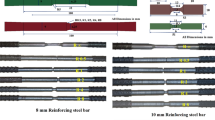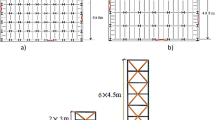Abstract
This paper presents a seismic topology optimization study of steel braced frames with shape memory alloy (SMA) braces. Optimal SMA-braced frames (SMA-BFs) with either Fe-based SMA or NiTi braces are determined in a performance-based seismic design context. The topology optimization is performed on 5- and 10-story SMA-BFs considering the placement, length, and cross-sectional area of SMA bracing members. Geometric, strength, and performance-based design constraints are considered in the optimization. The seismic response and collapse safety of topologically optimal SMA-BFs are assessed according to the FEMA P695 methodology. A comparative study on the optimal SMA-BFs is also presented in terms of total relative cost, collapse capacity, and peak and residual story drift. The results demonstrate that Fe-based SMA-BFs exhibit higher collapse capacity and more uniform distribution of lateral displacement over the frame height while being more cost-effective than NiTi braced frames. In addition to a lower unit price compared to NiTi, Fe-based SMAs reduce SMA material usage. In frames with Fe-based SMA braces, the SMA usage is reduced by up to 80%. The results highlight the need for using SMAs with larger recoverable strains.
Similar content being viewed by others
References
Auricchio F, Fugazza D, DesRoches R. Earthquake performance of steel frames with nitinol braces. Journal of Earthquake Engineering, 2006, 10(Suppl1): 45–66
McCormick J, DesRoches R, Fugazza D, Auricchio F. Seismic assessment of concentrically braced steel frames with shape memory alloy braces. Journal of Structural Engineering, 2007, 133(6): 862–870
Qiu C, Zhu S. Shake table test and numerical study of self-centering steel frame with SMA braces. Earthquake Engineering & Structural Dynamics, 2017, 46(1): 117–137
Asgarian B, Moradi S. Seismic response of steel braced frames with shape memory alloy braces. Journal of Constructional Steel Research, 2011, 67(1): 65–74
Miller D J, Fahnestock L A, Eatherton M R. Development and experimental validation of a nickel—titanium shape memory alloy self-centering buckling-restrained brace. Engineering Structures, 2012, 40: 288–298
Eatherton M R, Fahnestock L A, Miller D J. Computational study of self-centering buckling-restrained braced frame seismic performance. Earthquake Engineering & Structural Dynamics, 2014, 43(13): 1897–1914
Hu J W, Choi E. Seismic design, nonlinear analysis, and performance evaluation of recentering buckling-restrained braced frames (BRBFs). International Journal of Steel Structures, 2014, 14(4): 683–695
Qiu C, Li H, Ji K, Hou H, Tian L. Performance-based plastic design approach for multi-story self-centering concentrically braced frames using SMA braces. Engineering Structures, 2017, 153: 628–638
Qiu C X, Zhu S. Performance-based seismic design of self-centering steel frames with SMA-based braces. Engineering Structures, 2017, 130: 67–82
Qiu C, Zhao X, Zhang Y, Hou H. Robustness of performance-based plastic design method for SMABFs. International Journal of Steel Structures, 2019, 19(3): 787–805
Alaneme K K, Okotete E A, Anaele J U. Structural vibration mitigation—A concise review of the capabilities and applications of Cu and Fe based shape memory alloys in civil structures. Journal of Building Engineering, 2019, 22: 22–32
Alaneme K K, Okotete E A. Reconciling viability and cost-effective shape memory alloy options—A review of copper and iron based shape memory metallic systems. Engineering Science and Technology, an International Journal, 2016, 19(3): 1582–1592
Fang C, Wang W, Ji Y, Yam M C H. Superior low-cycle fatigue performance of iron-based SMA for seismic damping application. Journal of Constructional Steel Research, 2021, 184: 106817
Hou H, Li H, Qiu C, Zhang Y. Effect of hysteretic properties of SMAs on seismic behavior of self-centering concentrically braced frames. Structural Control and Health Monitoring, 2018, 25(3): e2110
Wang W, Fang C, Shen D, Zhang R, Ding J, Wu H. Performance assessment of disc spring-based self-centering braces for seismic hazard mitigation. Engineering Structures, 2021, 242: 112527
Fang C, Ping Y, Chen Y, Yam M C H, Chen J, Wang W. Seismic performance of self-centering steel frames with SMA-viscoelastic hybrid braces. Journal of Earthquake Engineering, 2020: 1–28
Fang C, Ping Y, Zheng Y, Chen Y. Probabilistic economic seismic loss estimation of steel braced frames incorporating emerging self-centering technologies. Engineering Structures, 2021, 241: 112486
Ozbulut O E, Roschke P N, Lin P Y, Loh C H. GA-based optimum design of a shape memory alloy device for seismic response mitigation. Smart Materials and Structures, 2010, 19(6): 065004
Liu M, Burns S A, Wen Y K. Multiobjective optimization for performance-based seismic design of steel moment frame structures. Earthquake Engineering & Structural Dynamics, 2005, 34(3): 289–306
Kaveh A, Farahmand Azar B, Hadidi A, Rezazadeh Sorochi F, Talatahari S. Performance-based seismic design of steel frames using ant colony optimization. Journal of Constructional Steel Research, 2010, 66(4): 566–574
Fragiadakis M, Lagaros N D, Papadrakakis M. Performance-based multiobjective optimum design of steel structures considering life-cycle cost. Structural and Multidisciplinary Optimization, 2006, 32(1): 1–11
Liang Q Q, Xie Y M, Steven G P. Optimal topology design of bracing systems for multistory steel frames. Journal of Structural Engineering, 2000, 126(7): 823–829
Stromberg L L, Beghini A, Baker W F, Paulino G H. Application of layout and topology optimization using pattern gradation for the conceptual design of buildings. Structural and Multidisciplinary Optimization, 2011, 43(2): 165–180
Bobby S, Spence S M J, Kareem A. Data-driven performance-based topology optimization of uncertain wind-excited tall buildings. Structural and Multidisciplinary Optimization, 2016, 54(6): 1379–1402
Gholizadeh S, Poorhoseini H. Seismic layout optimization of steel braced frames by an improved dolphin echolocation algorithm. Structural and Multidisciplinary Optimization, 2016, 54(4): 1011–1029
Hassanzadeh A, Gholizadeh S. Collapse-performance-aided design optimization of steel concentrically braced frames. Engineering Structures, 2019, 197: 109411
Vamvatsikos D, Cornell C A. Incremental dynamic analysis. Earthquake Engineering & Structural Dynamics, 2002, 31(3): 491–514
Hsiao P C, Lehman D E, Roeder C W. Evaluation of the response modification coefficient and collapse potential of special concentrically braced frames. Earthquake Engineering & Structural Dynamics, 2013, 42(10): 1547–1564
Moradi S, Alam M S, Asgarian B. Incremental dynamic analysis of steel frames equipped with NiTi shape memory alloy braces. Structural Design of Tall and Special Buildings, 2014, 23(18): 1406–1425
Shi F, Ozbulut O E, Zhou Y. Influence of shape memory alloy brace design parameters on seismic performance of self-centering steel frame buildings. Structural Control and Health Monitoring, 2020, 27(1): e2462
Gholizadeh S, Ebadijalal M. Performance based discrete topology optimization of steel braced frames by a new metaheuristic. Advances in Engineering Software, 2018, 123: 77–92
Gholizadeh S, Hassanzadeh A, Milany A, Ghatte H F. On the seismic collapse capacity of optimally designed steel braced frames. Engineering with Computers, 2020: 1–13
FEMA-P695. Quantification of Building Seismic Performance Factors. Washington, D.C.: Federal Emergency Management Agency, 2009
ASCE 41-13. Seismic Evaluation and Retrofit of Existing Buildings. Reston, VA: American Society of Civil Engineers, 2014
McKenna F, Fenves G L. OpenSees: The Open System for Earthquake Engineering Simulation. Berkeley, CA: Regents of the University of California, 2013
Math Works Inc. MATLAB, The Language of Technical Computing. 2019
DesRoches R, McCormick J, Delemont M. Cyclic properties of superelastic shape memory alloy wires and bars. Journal of Structural Engineering, 2004, 130(1): 38–46
Tanaka Y, Himuro Y, Kainuma R, Sutou Y, Omori T, Ishida K. Ferrous polycrystalline shape-memory alloy showing huge superelasticity. Science, 2010, 327(5972): 1488–1490
Fugazza D. Use of shape-memory alloy devices in earthquake engineering: Mechanical properties, advanced constitutive modeling and structural applications. Dissertation for the Doctoral Degree. Pavia: University of Pavia, 2005
Qiu C, Du X. Seismic performance of multistory CBFs with novel recentering energy dissipative braces. Journal of Constructional Steel Research, 2020, 168: 105864
Pham H. Performance-based assessments of buckling-restrained braced steel frames retrofitted by self-centering shape memory alloy braces. In: Georgia Tech Theses and Dissertations. Athens, GA: Georgia Institute of Technology, 2013
Beiraghi H, Zhou H. Dual-steel frame consisting of moment-resisting frame and shape memory alloy braces subjected to near-field earthquakes. Structural Design of Tall and Special Buildings, 2020, 29: e1784
Acknowledgements
The research presented in this paper was financially supported by the Ryerson University Faculty of Engineering and Architectural Science and the Natural Sciences and Engineering Research Council of Canada (NSERC) through Discovery Grant. The authors gratefully acknowledge these financial supports.
Author information
Authors and Affiliations
Corresponding author
Rights and permissions
About this article
Cite this article
Hassanzadeh, A., Moradi, S. Topology optimization and seismic collapse assessment of shape memory alloy (SMA)-braced frames: Effectiveness of Fe-based SMAs. Front. Struct. Civ. Eng. 16, 281–301 (2022). https://doi.org/10.1007/s11709-022-0807-3
Received:
Accepted:
Published:
Issue Date:
DOI: https://doi.org/10.1007/s11709-022-0807-3




